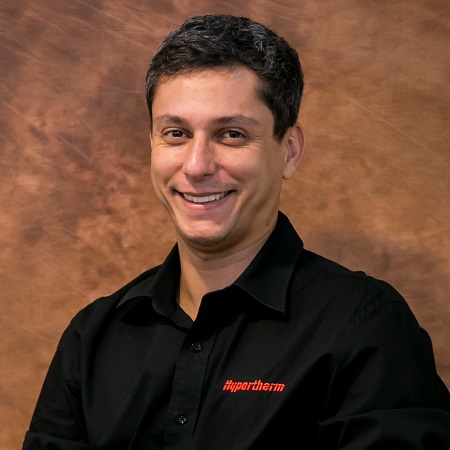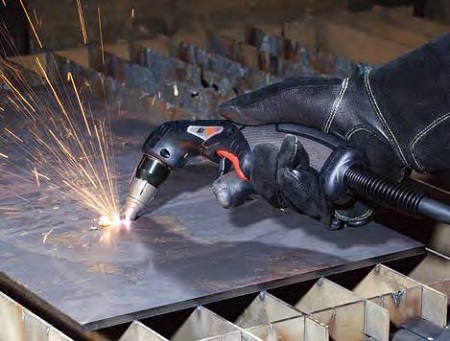
The Philippines is expected to grow faster than South East Asia as a whole over the next two decades, with overall GDP expanding by 4.8% per year in the 2014-33 period,” according to a report from Deloitte. There are reports that predict some companies are set to relocate their production from China, their traditional base, to the Philippines and neighbouring countries in South East Asia. These measures will help sustain the growth of the industrial sector in the years to come.
Although opportunities are vast in the Philippines, tapping the industrial manufacturing market will require nonconventional strategies. Industrial base is expected to continue expanding in the near term. But transition to high-complexity manufacturing is not going to happen overnight.
In an interview in line with the recent Philippine Die & Mould Machineries and Equipment Exhibition (PDMEX), International Metalworking News for Asia spoke to Wagner Turri, Sales Leader – South East Asia & Taiwan, Hypertherm.
IMNA: Which Hypertherm products were highlighted at the show? What are the special features of these products and how are these different from those available in the market today?
Wagner Turri: At the PDMEX trade event, we worked with our channel partner, Fuman Industries Inc. (Fuman), to showcase Hypertherm’s Powermax® range. The Powermax family is a series of highly portable, professional grade air plasma cutting and gouging systems. Built to withstand heavy-duty use in challenging industrial environments, the Powermax systems are an ideal choice for hand or automated cutting and gouging of any electrically conductive metal. Offering the best performance in its class, the Powermax systems feature state-of-the-art consumable technology that delivers faster speeds and better cut quality to help users enhance efficiency. Less experienced users will find the Powermax systems easy to operate especially with its high portability, simple controls, and a stable plasma arc.
The Powermax offers unique applications such as attachment or lug removal with our FlushCut consumables. The patented design of the FlushCut consumables allows users to cut as close to the base as possible, without piercing or damaging the workpiece, and increases efficiency compared to other solutions like oxyfuel, carbon arc gouging, or traditional plasma cutting tools. In addition, the Powermax is also equipped with straight torches that can be used on track burners and carriages for bevel cutting profiles — improving bevel cut quality and cutting speeds over oxyfuel technology. With the Powwermax45® XP, customers can also enjoy marking capabilities, which is suitable for marking on plates and parts for quality control purposes or to indicate welding positions.
One of the key products highlighted at the show was the Powermax30® AIR system — the smallest, lightest handheld plasma cutting system in its class that delivers big on performance. It includes its own built-in air compressor, so one can use the Powermax30 AIR anywhere there is single-phase power. Users will enjoy the ease of use — just plug it in, attach the work clamp, and the system is ready to cut.
IMNA: How important is R&D to Hypertherm for the development of new products? Did the company tap on special skills, special production processes, or innovative machineries/techniques to manufacture the products?
Wagner Turri: With 50 years of experience and close to 500 global patents, Hypertherm dedicates more resources to industrial cutting research, development, and testing than any other manufacturer in the world. Our company’s continuous advances in technology provide features that customers need and have come to rely on. For example, one of the key attributes our customers appreciate most is the increased consumable life, through which they are able to enhance productivity and lower their cutting costs. Hypertherm’s parts are designed and optimised for each torch, power supply, and application. These parts are subjected to extensive tests — assuring customers that their equipment will deliver optimal life and cut quality.
IMNA: What are some key trends that are shaping the metalworking industry? How have these developments impacted Hypertherm?
Wagner Turri: We anticipate more challenging times ahead for the regional metalworking industry, in which competitiveness will be driven by customer’s needs and prompt feedback for opportunities and improvements. Industrial automation and digitalisation are set to be the key drivers of change, and the climate would be more demanding in Asia Pacific due to future economic growth and the competitive landscape. This trend will propel the metalworking industry to set new norms, where product quality is considered a ‘standard’ feature and customers’ requests are influenced by positive experiences in their interaction with these products, services, or solutions.
Over the last few years, we have seen a growing number of solutions that encourage the introduction of automation and digitalisation to the metalworking industry. Technologies that are related to the Industrial Internet of Things (IIoT) are enabling companies to build up smarter job shops, allowing the industry to establish a smart machinery eco-system.
Automation and digitalisation embedded in the IIoT platform have given manufacturers enhanced equipment and process capabilities, and have supported them in improving production effectiveness and measures for cost management. In the last three years, Hypertherm has been addressing these industrial demands and trends with the development of a new set of plasma source and controllers, and by improving on-time operations support to customers. Our cutting-edge solution — the X-Definition™ plasma source and NC industrial controller — provides real-time feedback on performance to job shops via a Wi-Fi connection. This Wi-Fi connectivity enables metalworking job shops to connect to these machines with a single device (e.g. smart phone or computer) to collect data on machine performance and maintenance. In addition, our new set of NC industrial controllers can receive cutting nesting jobs through Wi-Fi. Furthermore, Hypertherm employs the most advanced communication protocol (i.e. EtherCAT) to provide faster information flow when our products are integrated with an automated solution, such as a NC plasma machine, for straight or bevel cutting, or a plasma robotic arm for 3D or pipe cutting.
Technological advances like these continue to elevate Hypertherm’s plasma cutting capabilities. In addition, our wide range of solutions for automation and portability include new sets of robotic cutting tools and applications, delivered by our new rotary sleeve mechanical solution and the introduction of our off-line robotic software. In this way, Hypertherm offers unmatched cut quality and precision (up to ISO 9013 Range 2) through our latest X-Definition class plasma system. This solution offers users reduced operation costs with its new electronic feature that extends consumable life, avoiding premature damage or misuse. With its new process technologies that deliver high cutting performance at optimal costs, our X-Definition plasma system is an outstanding example of how we are able to address the changes ahead for manufacturers.
IMNA: How important is the Philippines market to Hypertherm? Do you have any plans to expand your operations or market reach here in the Philippines? Where and when?
Wagner Turri: Hypertherm has been actively promoting its solutions across the Asia market, educating users on how its technologies can be beneficial to their business. We have been in the Philippines for more than 15 years serving a wide range of industries through a partnership with Fuman.
Over the years, we have observed significant year-on-year growth and expansion, through working closely with our customers from various sectors, including signages, construction, metal fabrication, and structural steel. We foresee our customers in the Philippines looking to be more competitive in their local market, especially with the wave of infrastructure projects coming up across the country. Our cutting solutions, promoted by Fuman at the PDMEX show, cover most of our customers’ needs, especially with regard to keeping operational costs low through leveraging on our technologies.
As the economy continues to grow across Asia, companies will continue to expand their operations, optimise to reduce cost, and expand capabilities to capture new markets. This will result in a continuous demand for efficient metal cutting solutions, and we look forward to new partnerships to meet those manufacturers’ cutting needs.















